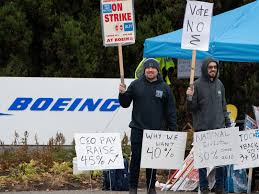Over 3,200 union workers at Boeing’s defence manufacturing operations in Missouri and Illinois have embarked on a strike, protesting the company’s latest contract offer, which they say falls short on key issues like pay, pensions, and working conditions.
The strike, which began at midnight, is being led by the International Association of Machinists and Aerospace Workers (IAM), one of the largest labour unions in the United States. The walkout affects Boeing’s defence division, which is responsible for building military aircraft such as the F-15 fighter jet.
In a statement released on social media platform X, the union said, “3,200 highly-skilled IAM Union members at Boeing went on strike at midnight because enough is enough. This is about respect and dignity, not empty promises.”
The union’s members rejected Boeing’s most recent offer, which the company said included an average 40% wage increase. Dan Gillian, Vice President of Boeing’s Air Dominance unit, expressed disappointment in the outcome, stating, “We’re disappointed our employees rejected an offer that featured 40% average wage growth.”
This is the first strike at Boeing’s defence operations since 1996, when a similar industrial action lasted more than three months. Analysts say the current dispute marks a serious escalation in tensions between management and organised labour at Boeing, which has faced multiple operational and reputational setbacks in recent years.
The company is still trying to recover from a series of damaging crises, including safety concerns surrounding its commercial aircraft and a costly strike in 2023 by around 30,000 workers in its passenger aircraft division. That action lasted nearly eight weeks and is estimated to have cost Boeing billions of dollars.
Boeing’s CEO Kelly Ortberg has attempted to downplay the significance of the current defence-related strike. Speaking last week, he said, “I wouldn’t worry too much about the implications of the strike. We’ll manage our way through that.” He added that the scale of the strike is much smaller than last year’s industrial action by passenger aircraft workers.
However, the timing of the walkout is a setback for Boeing’s turnaround efforts, especially in its defence unit, which the company has counted on to deliver more stable results while its commercial aircraft business struggles.
In addition to labour unrest, Boeing is grappling with the long-term fallout from several aviation incidents that have tarnished its safety record. The most high-profile were two deadly crashes involving its 737 Max aircraft—in Indonesia in 2018 and Ethiopia in 2019—that killed a total of 346 people. These tragedies triggered global investigations, grounded fleets, and damaged public trust in the brand.
In 2024, a separate incident occurred when a panel covering an unused emergency exit on a Boeing 737 Max aircraft detached mid-air. Although there were no fatalities, the incident reignited safety concerns.
Boeing’s production numbers also reflect its broader challenges. In 2024, the company delivered just 348 aircraft to customers, its lowest output since the COVID-19 pandemic disrupted global aviation in 2020.
IAM, which represents around 600,000 workers across the aerospace, defence, shipbuilding, and manufacturing sectors, has remained firm in its demands. Union leaders say workers are seeking not just better pay, but also more stable pension plans and improved scheduling that respects their time and wellbeing.
Industry observers say the company may need to rethink its labour relations strategy, especially as it faces rising pressure from customers, regulators, and investors to stabilise its operations.
While Boeing insists it can manage the fallout from the current strike, the broader picture suggests the company is still in a prolonged period of turbulence. Whether it can achieve a lasting recovery may depend in part on how it handles both its workforce and its mounting operational challenges.
